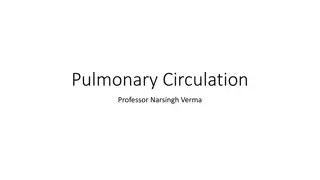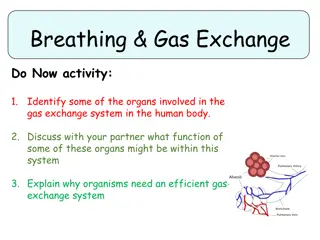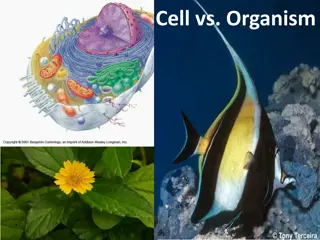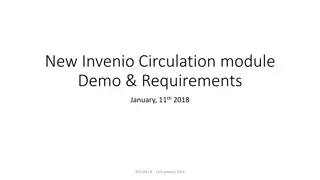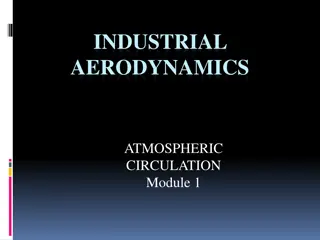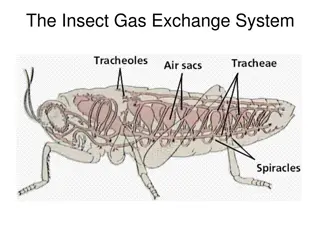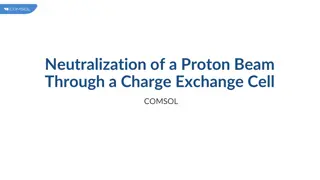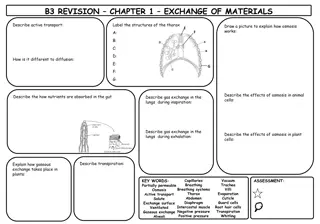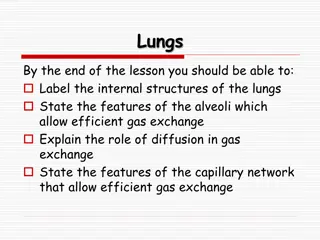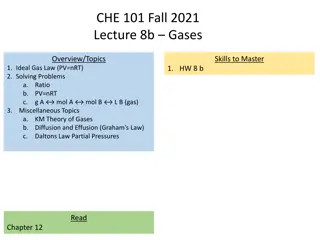Animal Circulation and Gas Exchange Systems Overview
The lecture explores the importance of circulation and gas exchange systems in animals, covering topics such as the evolution of double circulation, blood structure and function, respiratory pigments, and the necessity of oxygen acquisition and carbon dioxide release in diverse animal species. It also highlights a unique discovery of metazoans that thrive in permanently anoxic conditions. Circulation systems play a crucial role in moving gases and essential resources throughout an animal's body, while respiratory systems facilitate gas exchange with the environment.
Download Presentation

Please find below an Image/Link to download the presentation.
The content on the website is provided AS IS for your information and personal use only. It may not be sold, licensed, or shared on other websites without obtaining consent from the author.If you encounter any issues during the download, it is possible that the publisher has removed the file from their server.
You are allowed to download the files provided on this website for personal or commercial use, subject to the condition that they are used lawfully. All files are the property of their respective owners.
The content on the website is provided AS IS for your information and personal use only. It may not be sold, licensed, or shared on other websites without obtaining consent from the author.
E N D
Presentation Transcript
Lecture #11 Animal Circulation and Gas Exchange Systems 1
Key Concepts: Circulation and gas exchange why? Circulation spanning diversity Hearts the evolution of double circulation Blood circulation and capillary exchange Blood structure and function Gas exchange spanning diversity Breathing spanning diversity Respiratory pigments 2
Animals use O2 and produce CO2 All animals are aerobic Lots of oxygen is required to support active mobility Some animals use lots of oxygen to maintain body temperature All animals produce CO2 as a byproduct of aerobic respiration Gasses must be exchanged Oxygen must be acquired from the environment Carbon dioxide must be released to the environment 3
Exceptbreaking news! http://www.biomedcentral.com/1741-7007/8/30 Abstract 6 April 2010 Background Several unicellular organisms (prokaryotes and protozoa) can live under permanently anoxic conditions. Although a few metazoans can survive temporarily in the absence of oxygen, it is believed that multi- cellular organisms cannot spend their entire life cycle without free oxygen. Deep seas include some of the most extreme ecosystems on Earth, such as the deep hypersaline anoxic basins of the Mediterranean Sea. These are permanently anoxic systems inhabited by a huge and partly unexplored microbial biodiversity. Results During the last ten years three oceanographic expeditions were conducted to search for the presence of living fauna in the sediments of the deep anoxic hypersaline L'Atalante basin (Mediterranean Sea). We report here that the sediments of the L'Atalante basin are inhabited by three species of the animal phylum Loricifera (Spinoloricus nov. sp., Rugiloricus nov. sp. and Pliciloricus nov. sp.) new to science. Using radioactive tracers, biochemical analyses, quantitative X-ray microanalysis and infrared spectroscopy, scanning and transmission electron microscopy observations on ultra-sections, we provide evidence that these organisms are metabolically active and show specific adaptations to the extreme conditions of the deep basin, such as the lack of mitochondria, and a large number of hydrogenosome-like organelles, associated with endosymbiotic prokaryotes. Conclusions This is the first evidence of a metazoan life cycle that is spent entirely in permanently anoxic sediments. Our findings allow us also to conclude that these metazoans live under anoxic conditions through an obligate anaerobic metabolism that is similar to that demonstrated so far only for unicellular eukaryotes. The discovery of these life forms opens new perspectives for the study of metazoan life in habitats lacking molecular oxygen. 4
Animals use O2 and produce CO2 Circulation systems move gasses (and other essential resources such as nutrients, hormones, etc) throughout the animal s body Respiratory systems exchange gasses with the environment 5
Circulation systems have evolved over time The most primitive animals exchange gasses and circulate resources entirely by diffusion Process is slow and cannot support 3-D large bodies Sponges, jellies and flatworms use diffusion alone 6
Critical Thinking Why isn t diffusion adequate for exchange in a 3D large animal??? 7
Critical Thinking Why isn t diffusion adequate for exchange in a 3D large animal??? 8
Critical Thinking But ..plants rely on diffusion for gas exchange ..how do they get so big??? 9
Critical Thinking But ..plants rely on diffusion for gas exchange ..how do they get so big??? 10
Circulation systems have evolved over time The most primitive animals exchange gasses and circulate resources entirely by diffusion Process is slow and cannot support 3-D large bodies Surface area / volume ratio becomes too small Sponges, jellies and flatworms use diffusion alone 11
Virtually every cell in a sponge is in direct contact with the water little circulation is required Diagram of sponge structure 12
Jellies and flatworms have thin bodies and elaborately branched gastrovascular cavities Again, all cells are very close to the external environment This facilitates diffusion Some contractions help circulate (contractile fibers in jellies, muscles in flatworms) Diagram of jellyfish structure, and photos 13
Circulation systems have evolved over time Most invertebrates (esp. insects) have an open circulatory system Metabolic energy is used to pump hemolymph through blood vessels into the body cavity Hemolymph is returned to vessels via ostia pores that draw in the fluid as the heart relaxes Diagram of open circulatory system in a grasshopper 14
Circulation systems have evolved over time Closed circulatory systems separate blood from interstitial fluid Metabolic energy is used to pump blood through blood vessels Blood is contained within the vessels Exchange occurs by diffusion in capillary beds Diagram of a closed circulatory system, plus a diagram showing an earthworm circulatory system 15
Open vs. Closedboth systems are common Open systems . Use less metabolic energy to run Use less metabolic energy to build Can function as a hydrostatic skeleton Most invertebrates (except earthworms and larger mollusks) have open systems Closed systems . Maintain higher pressure Are more effective at transport Supply more oxygen to support larger and more active animals All vertebrates have closed systems 16
All vertebrates have a closed circulatory system Chambered heart pumps blood Atria receive blood Ventricles pump blood Vessels contain the blood Veins carry blood to atria Arteries carry blood from ventricles Capillary beds facilitate exchange Capillary beds separate arteries from veins Highly branched and very tiny Infiltrate all tissues in the body We ll go over these step by step 17
Chambered heart pumps blood Atria receive blood Ventricles pump blood Diagram of a chambered heart One-way valves direct blood flow 18
Critical Thinking Atria receive blood; ventricles pump Given that function, what structure would you predict??? 19
Critical Thinking Atria receive blood; ventricles pump Given that function, what structure would you predict??? 20
Chambered heart pumps blood Atria receive blood Soft walled, flexible Ventricles pump blood Thick, muscular walls One-way valves direct blood flow Diagram of a chambered heart 21
Vessels contain the blood Arteries carry blood from ventricles Always under pressure Veins carry blood to atria One-way valves prevent back flow Body movements increase circulation Pressure is always low Diagram showing artery, vein and capillary bed 22
Note that blood vessel names reflect the direction of flow, NOT the amount of oxygen in the blood Arteries carry blood AWAY from the heart Arterial blood is always under pressure It is NOT always oxygenated Veins carry blood TO the heart Diagram of blood circulation pattern in humans 23
Capillary beds facilitate exchange Capillary beds separate arteries from veins Highly branched and very tiny Infiltrate all tissues in the body More later Diagram showing artery, vein and capillary bed 24
All vertebrates have a closed circulatory system REVIEW Chambered heart pumps blood Atria receive blood Ventricles pump blood Vessels contain the blood Veins carry blood to atria Arteries carry blood from ventricles Capillary beds facilitate exchange Capillary beds separate arteries from veins Highly branched and very tiny Infiltrate all tissues in the body 25
Evolution of double circulation not all animals have a 4-chambered heart Diagram showing progression from a 1- chambered heart to a 4-chambered heart. This diagram is used in the next 12 slides. 26
Fishes have a 2-chambered heart One atrium, one ventricle A single pump of the heart circulates blood through 2 capillary beds in a single circuit Blood pressure drops as blood enters the capillaries (increase in cross-sectional area of vessels) Blood flow to systemic capillaries and back to the heart is very slow Flow is increased by swimming movements 27
Two circuits increases the efficiency of gas exchange = double circulation One circuit goes to exchange surface One circuit goes to body systems Both under high pressure increases flow rate 28
Amphibians have a 3-chambered heart Two atria, one ventricle Ventricle pumps to 2 circuits One circuit goes to lungs and skin to release CO2 and acquire O2 The other circulates through body tissues Oxygen rich and oxygen poor blood mix in the ventricle A ridge helps to direct flow Second pump increases the speed of O2 delivery to the body 29
Most reptiles also have a 3-chambered heart A partial septum further separates the blood flow and decreases mixing Crocodilians have a complete septum Point of interest: reptiles have two arteries that lead to the systemic circuits Arterial valves help direct blood flow away from pulmonary circuit when animal is submerged 30
Critical Thinking What is a disadvantage of a 3 chambered heart??? 31
Critical Thinking What is a disadvantage of a 3 chambered heart??? 32
Mammals and birds have 4-chambered hearts Two atria and two ventricles Oxygen rich blood is completely separated from oxygen poor blood No mixing much more efficient gas transport Efficient gas transport is essential for both movement and support of endothermy Endotherms use 10-30x more energy to maintain body temperatures 33
Mammals and birds have 4-chambered hearts Mammals and birds are NOT monophyletic What does this mean??? 34
Mammals and birds have 4-chambered hearts Mammals and birds are NOT monophyletic Phylogenetic tree showing the diversification of vertebrates 35
Mammals and birds have 4-chambered hearts Mammals and birds are NOT monophyletic Four-chambered hearts evolved independently What s this called??? 36
Mammals and birds have 4-chambered hearts Mammals and birds are NOT monophyletic Four-chambered hearts evolved independently 37
Blood Circulation Blood vessels are organs Outer layer is elastic connective tissue Middle layer is smooth muscle and elastic fibers Inner layer is endothelial tissue Arteries have thicker walls Capillaries have only an endothelium and basement membrane 39
Critical Thinking Arteries have thicker walls than veins Capillaries have only an endothelium and basement membrane What is the functional significance of this structural difference??? 40
Critical Thinking Arteries have thicker walls than veins Capillaries have only an endothelium and basement membrane What is the functional significance of this structural difference??? 41
Form reflects function Arteries are under more pressure than veins Capillaries are the exchange surface Diagram showing artery, vein and capillary bed 42
Blood pressure and velocity drop as blood moves through capillaries Graph showing relationships between blood pressure, blood velocity, and the cross- sectional area of different kinds of blood vessels arteries to capillaries to veins. This same graph is on the next 3 slides. 43
Total cross- sectional area in capillary beds is much higher than in arteries or veins; slows flow 44
Velocity increases as blood passes into veins (smaller cross- sectional area); pressure remains dissipated 45
One-way valves and body movements force blood back to right heart atrium 46
Critical Thinking What makes rivers curl on the Coastal Plain??? 47
Critical Thinking What makes rivers curl on the Coastal Plain??? 48
Emphasize the difference between velocity and pressure!!! Velocity increases in the venous system; pressure does NOT 49
Capillary Exchange Gas exchange and other transfers occur in the capillary beds Muscle contractions determine which beds are open Brain, heart, kidneys and liver are generally always fully open Digestive system capillaries open after a meal Skeletal muscle capillaries open during exercise etc 50





